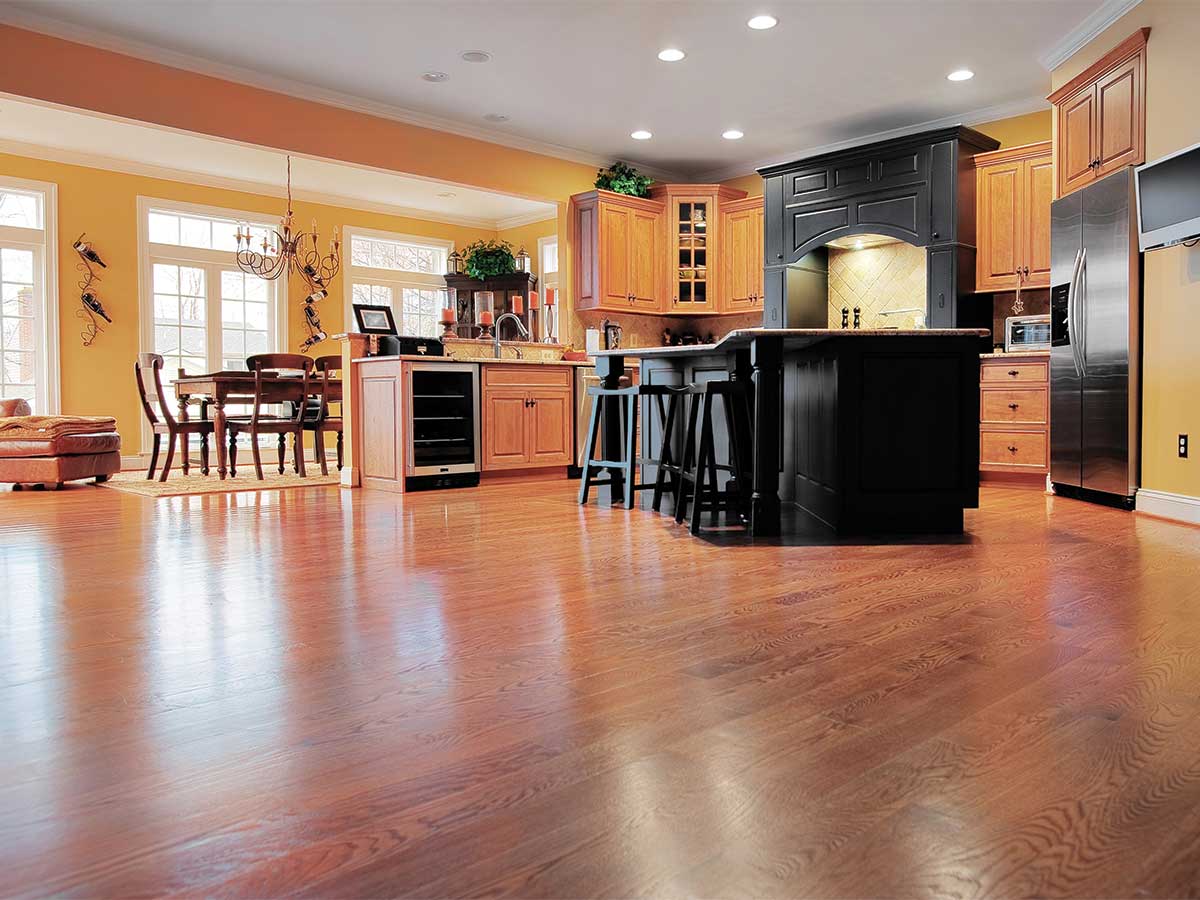Do Hardwood Floors Make Your House Colder?

Hardwood floors do not make your house colder. They have moderate thermal conductivity, which means they can help insulate your home, especially if the wood is thick and high-quality.
Proper installation, good insulating materials, and sealing gaps can improve insulation. You can also use radiant floor heating to warm hardwood floors, spreading heat evenly and keeping the room cozy.
Area rugs can make the floors warmer and more comfortable. If you want to keep your home warm with hardwood floors, there are many strategies and techniques to consider.
Thermal Properties of Hardwood
Hardwood flooring offers several benefits beyond its aesthetic appeal, including its ability to help insulate and maintain warmth in your home during winter. Here’s a detailed look at its thermal properties and how they contribute to home insulation:
- Moderate Thermal Conductivity: Hardwood has moderate thermal conductivity, which means it can help slow down the transfer of heat through your floors. While it may not insulate as effectively as dedicated insulation materials, hardwood can still contribute to reducing heat loss.
- Density and Stability: Hardwood’s density and stability play a crucial role in its thermal performance. Dense hardwood varieties can better retain heat and help maintain stable indoor temperatures, enhancing comfort during colder months.
- Effect of Wood Type and Thickness: The type of wood and its thickness impact its insulating properties. Generally, denser woods like oak or maple provide better insulation than softer woods. Thicker hardwood flooring can also offer enhanced thermal performance.
- Proper Installation: Proper installation techniques, such as using underlayment or insulating materials beneath hardwood flooring, can further improve its insulating capabilities. These materials create an additional barrier against heat loss and enhance the overall efficiency of the flooring system.
- Benefits for Home Comfort: By choosing hardwood flooring with good thermal properties and ensuring correct installation, you can create a cozy and energy-efficient environment in your home. Hardwood not only adds beauty but also contributes to a more comfortable living space by reducing drafts and maintaining a more consistent indoor temperature.
Hardwood flooring is a valuable choice for homeowners seeking both aesthetic appeal and practical benefits such as improved home insulation. Choosing the right type of hardwood and ensuring proper installation are key steps toward maximizing its thermal efficiency and enjoying a warmer, more comfortable home during winter.
Factors Affecting Temperature
Maintaining warmth and comfort with hardwood floors involves several considerations beyond the flooring material itself. Here are the key factors that impact how well hardwood floors keep your home warm:
Quality of Insulation:
The effectiveness of insulation beneath hardwood floors is crucial in preventing heat loss. Good insulation blocks cold air from penetrating through the subfloor, thereby reducing the workload on your heating system and helping to maintain a comfortable indoor temperature.
Heating System Efficiency:
The efficiency and type of heating system in your home play a significant role in how warm your hardwood floors feel. Underfloor heating systems, for example, can distribute heat evenly across the floor surface, enhancing comfort levels. Regular maintenance of your heating system ensures it operates efficiently, minimizing cold spots and ensuring consistent warmth throughout your home.
Impact of Weather Changes:
External weather conditions directly influence how quickly floors lose heat. During colder periods, hardwood floors may lose heat faster, necessitating effective insulation and a reliable heating system to maintain indoor comfort levels.
By addressing these factors—ensuring adequate insulation, maintaining your heating system, and considering the impact of weather changes—you can optimize the warmth and comfort provided by hardwood floors in your home. This proactive approach not only enhances living conditions but also maximizes the energy efficiency of your heating system, contributing to long-term cost savings and environmental benefits.
Room Temperature Dynamics
Understanding how room temperature interacts with hardwood floors is essential for maintaining warmth and energy efficiency in your home. Here are key considerations:
Temperature Influence on Hardwood Floors:
Hardwood floors reflect the temperature of their environment. If the room is cold, the floor will also feel cold. This can affect the overall comfort levels in your home, especially during colder seasons.
Role of Insulation:
Effective insulation is crucial for maintaining a warm room temperature and preventing hardwood floors from feeling excessively cold. Proper insulation helps retain heat within the room, reducing the workload on heating systems and improving energy efficiency.
Interaction with Heat Sources:
Hardwood floors interact with various heat sources within the room. For instance, radiant heating systems installed beneath hardwood floors can provide consistent warmth throughout the flooring surface. This type of heating system ensures that the floor remains comfortable to walk on and contributes to a more energy-efficient heating solution.
Optimizing Heating Placement and Air Flow:
Strategically placing heaters and ensuring proper air circulation can enhance the efficiency of your heating system. Placing heaters in optimal locations and maintaining adequate air flow helps distribute heat evenly across the room, minimizing cold spots and ensuring overall comfort.
By considering these factors—room temperature influence, the role of insulation, interaction with heat sources, and optimizing heating strategies—you can effectively maintain warmth and energy efficiency in rooms with hardwood floors. This approach not only enhances comfort but also supports sustainable energy practices within your home.
Insulating Techniques
Proper insulation is indeed critical for maintaining warmth in hardwood floors and enhancing energy efficiency in your home. Here’s how you can effectively improve insulation beneath hardwood floors:
Addressing Poor Insulation:
The primary reason hardwood floors feel cold is inadequate insulation beneath them. Adding a robust layer of insulation helps retain heat within the room and prevents cold drafts from permeating through gaps in the flooring.
Choosing High-Quality Insulating Materials:
Opt for high-quality insulating materials such as rigid foam boards or spray foam insulation. These modern materials provide superior thermal insulation compared to older types, effectively trapping heat and enhancing comfort levels in your home.
Special Underlayment Products:
Consider using specialized underlayment products designed for hardwood floors. These underlayments not only improve insulation but also reduce noise transmission, creating a quieter and more comfortable living environment.
Sealing Gaps and Cracks:
Seal gaps and cracks where drafts can enter around the edges and baseboards of the floor. Use caulk or weatherstripping to effectively block cold air infiltration, further enhancing insulation and energy efficiency.
By implementing these measures—adding strong insulation, choosing high-quality insulating materials, using specialized underlayment products, and sealing gaps—you can significantly improve the warmth and comfort of hardwood floors in your home. These steps not only make your living space more comfortable but also contribute to energy savings and overall home efficiency.
Balancing Humidity Levels
Maintaining optimal humidity levels is crucial for creating a comfortable and balanced indoor environment. Carpets can play a significant role in balancing humidity levels within a space. Here are three ways carpets help achieve this:
- Moisture Absorption: Carpets have the ability to absorb excess moisture from the air, helping to reduce humidity levels in a room. This can be particularly beneficial in areas with high humidity or during humid seasons.
- Humidity Regulation: Carpets act as natural insulators, preventing rapid temperature fluctuations and regulating humidity levels. They can help retain moisture during dry periods and release it when the air becomes too humid, thus maintaining a consistent and comfortable indoor atmosphere.
- Preventing Condensation: By absorbing excess moisture from the air, carpets also help prevent condensation on floors and walls. Condensation can lead to mold growth and structural damage, but with the presence of carpets, this risk is significantly reduced.
Carpets contribute to maintaining balanced humidity levels by absorbing excess moisture, regulating humidity fluctuations, and preventing condensation. By incorporating carpets into your indoor spaces, you can create a more comfortable environment while reducing the risks associated with high or low humidity levels.
Radiant Floor Heating
Radiant floor heating is indeed an excellent choice for warming hardwood floors effectively and efficiently. Here are the key benefits and considerations:
Even Heat Distribution:
Radiant floor heating systems distribute heat evenly across the entire surface of the floor. Whether using electric heating elements or hot water tubes (hydronic systems), this method ensures that the hardwood floor remains consistently warm throughout, eliminating cold spots commonly found with other heating systems.
Energy Efficiency:
Radiant floor heating operates more efficiently than traditional forced-air systems because it directly heats the floor and objects in the room, rather than relying on blowing heated air through ducts. This method reduces heat loss and improves energy efficiency, ultimately saving on heating costs.
Compatibility with Hardwood Floors:
Hardwood floors are well-suited for radiant heating systems due to their ability to conduct and retain heat effectively. The heat from the radiant system transfers efficiently through the hardwood surface, creating a cozy and comfortable environment in your home.
Comfort and Aesthetic Appeal:
Beyond functionality, radiant floor heating enhances the comfort of living spaces by providing gentle, radiant warmth. It also complements the aesthetic appeal of hardwood floors, maintaining their natural beauty while ensuring a warm and inviting atmosphere, especially during colder months.
Installation Considerations:
When installing radiant floor heating with hardwood floors, it’s essential to follow manufacturer guidelines and ensure proper insulation beneath the flooring to maximize energy efficiency and heat retention.
Radiant floor heating is a smart investment for homeowners looking to enhance comfort, improve energy efficiency, and maintain the longevity of their hardwood floors. Its ability to provide consistent warmth without compromising aesthetics makes it a preferred choice for modern heating solutions.
Hardwood Vs. Other Floors
When comparing hardwood floors to other types of flooring, several factors like heat retention, aesthetics, and durability come into play:
Heat Retention:
Hardwood floors, especially solid wood, are known for their classic beauty and strength but may not retain heat as effectively as other flooring types. This characteristic can make rooms feel colder, particularly in colder climates. Carpet, laminate, and luxury vinyl flooring, with their insulating properties and layered construction, typically retain heat better, making them warmer options for chilly environments.
Aesthetics:
Hardwood floors are highly valued for their timeless appeal and elegant appearance. They add a sophisticated and stylish touch to any home décor, enhancing the overall aesthetic quality of living spaces. The natural grain patterns and rich colors of hardwood contribute to its enduring popularity in interior design.
Durability:
One of the significant advantages of hardwood floors is their durability and longevity. When properly maintained, hardwood can last for many years, even decades. Regular care, such as routine cleaning and occasional refinishing, helps preserve its beauty and structural integrity over time.
Practical Considerations:
If warmth is a primary concern, choosing flooring that retains heat well, such as carpet, laminate, or luxury vinyl, might be more suitable, especially in colder climates or rooms with limited insulation. However, hardwood floors can still be a preferred choice for their aesthetic appeal and durability, particularly when complemented with effective heating solutions like radiant floor heating or area rugs.
While hardwood floors may not retain heat as effectively as other flooring types, their classic beauty, durability, and timeless appeal often outweigh this consideration for many homeowners. Understanding your specific needs and preferences can guide you in selecting the flooring that best suits your lifestyle and enhances the comfort and style of your home.
Using Area Rugs
Adding area rugs to rooms with hardwood floors is indeed a practical and stylish way to enhance warmth and comfort. Here are the benefits and considerations:
Enhanced Comfort and Warmth:
Hardwood floors can feel cold, especially in colder seasons. Area rugs provide an extra layer of insulation, helping to keep rooms warmer and more comfortable. They offer a softer surface to walk on, which can be particularly welcoming in living areas, bedrooms, or hallways.
Aesthetic Enhancement:
Area rugs allow you to personalize your space by adding color, texture, and style to your room’s decor. They can serve as focal points or complement existing furniture and design elements. Choosing rugs that harmonize with your overall aesthetic enhances the visual appeal of your home.
Practical Benefits:
Materials like wool are excellent choices for area rugs because they naturally retain heat, contributing to improved insulation on hardwood floors. Layering rugs not only enhances warmth but also adds depth and dimension to your interior design.
Floor Protection:
Placing area rugs in high-traffic areas helps protect hardwood floors from wear and tear. Rugs act as a buffer against scratches, scuffs, and other damage caused by foot traffic, furniture movement, and daily activities.
Strategic Placement:
To maximize the benefits of area rugs, place them in areas where people frequently walk or stand, such as living room seating areas, dining spaces, and hallways. This placement not only improves comfort but also preserves the longevity of your hardwood flooring.
Incorporating stylish and functional area rugs into rooms with hardwood floors not only enhances warmth and comfort but also adds aesthetic appeal and protects your flooring investment. By choosing rugs wisely and strategically placing them throughout your home, you can create a cozy and inviting living environment while maintaining the timeless beauty of hardwood floors.
Seasonal Comfort Tips
To maintain comfort throughout the year, adjusting your home’s features based on the seasons can make a significant difference. Here are some tips for winter and summer adjustments, particularly concerning hardwood floors:
Winter Tips:
- Window Coverings: Use thick curtains or drapes to block drafts and retain heat. This helps in keeping rooms warmer, especially with hardwood floors that may feel colder.
- Heating Systems: Consider radiant heating systems, which distribute warmth evenly across the floor and complement hardwood flooring well. Ensure your heating systems are regularly checked and maintained for optimal efficiency and cost savings.
- Area Rugs: Place area rugs strategically in rooms to add insulation and warmth to hardwood floors. This not only enhances comfort but also contributes to the aesthetic appeal of the room.
Summer Tips:
- Window Coverings: Switch to lighter curtains or shades that allow better airflow and natural light. This helps in keeping rooms cooler during warmer months.
- Area Rugs: Consider temporarily removing or rolling up heavy area rugs to allow better air circulation and cooling of hardwood floors.
- Decorative Fabrics: Opt for light, breathable fabrics for decor items such as pillows, throws, and upholstery. This can create a cooler and more comfortable atmosphere in your home during summer.
By adapting these seasonal tips, you can effectively manage the temperature and comfort levels of your home year-round, ensuring that your hardwood floors remain a beautiful and functional feature in any season.


















